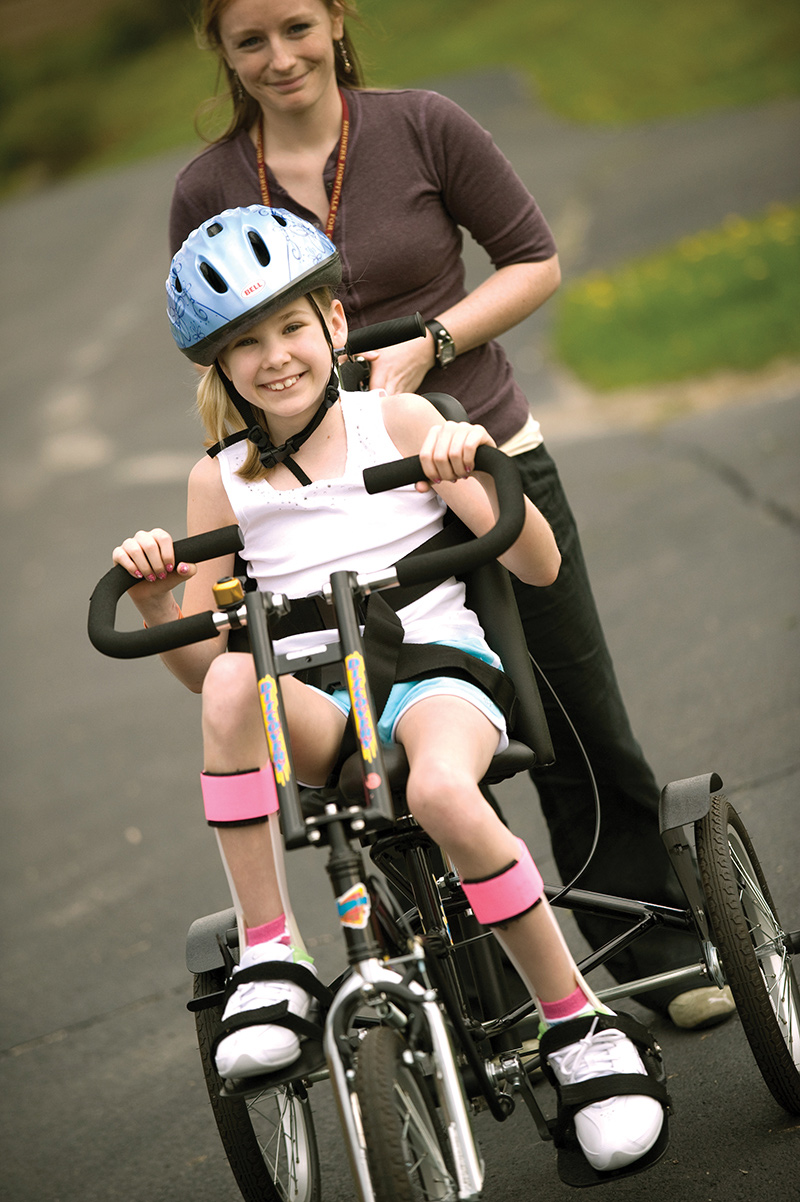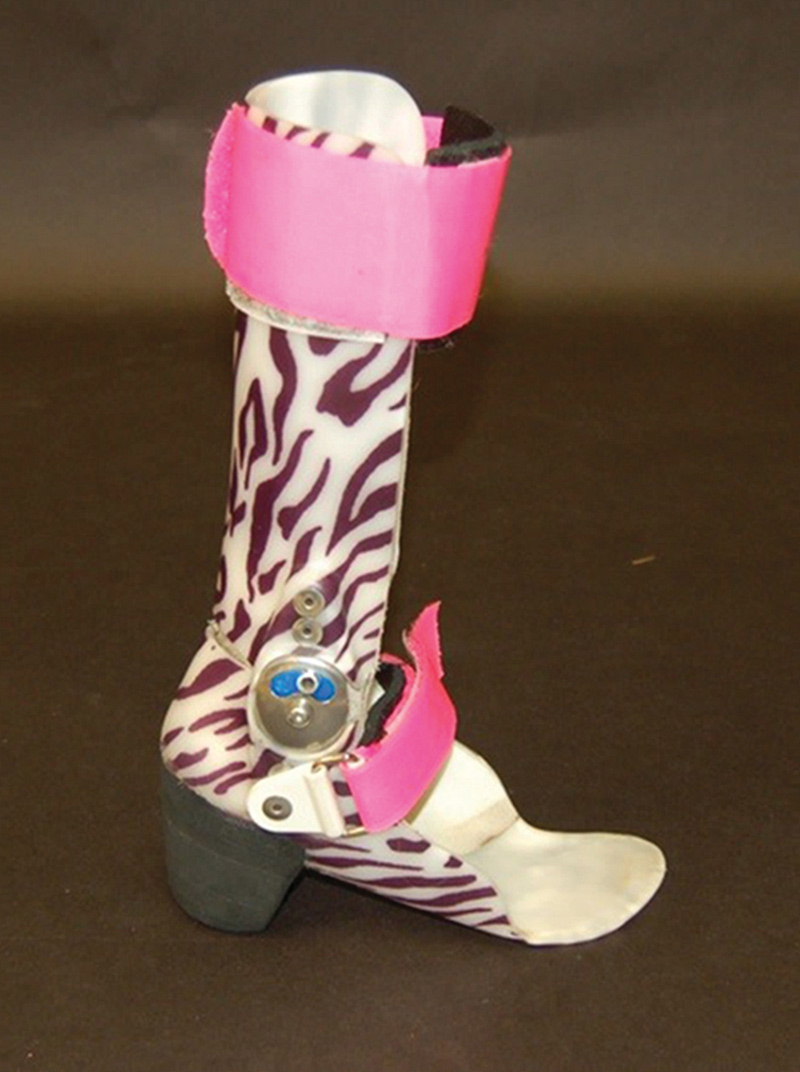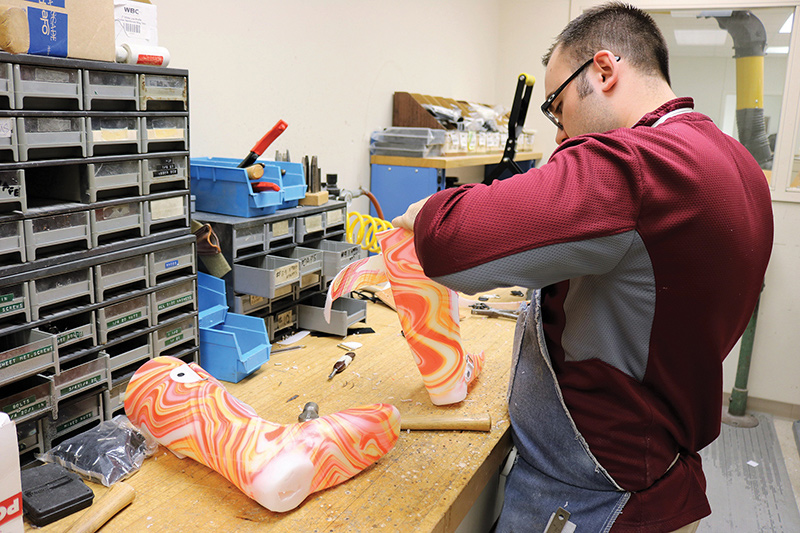Fine-tuning orthotic device prescription and fitting in CP
Half of those diagnosed with cerebral palsy have been prescribed standard AFOs to aid in walking, according to United Cerebral Palsy and the CDC.

A patient with CP at Shriners Hospital for Children—Chicago wearing his customized AFOs. Photo courtesy of Shriners Hospital for Children— Chicago
By P.K. Daniel, Lower Extremity Review May 2017
The heterogeneity of cerebral palsy means individual responses to orthotic devices vary widely. Moving beyond standardized care to match orthotic prescriptions to each child’s unique gait issues, as well as to their individual footwear needs, however, will likely improve outcomes for all.
J.M. is a chatty little 8-year-old girl with long brown hair. She has hemiplegic cerebral palsy (CP) and has been treated at Shriners Hospital for Children—Chicago since 2013. She has a foot drop, knee hyperextension, and decreased hip motion. Her condition used to require botulinum-A toxin (Botox) injections every three to six months. Her ankle foot orthosis (AFO) gave her sores.

Brittany, a patient at Shriners Hospital for Children—Chicago, rides an adaptive bike with a recreation therapist. Photo courtesy of Shriners Hospital for Children—Chicago
But last year, she received a tuned AFO—carefully adjusted for optimum alignment in combination with footwear—while under the care of senior physical therapist Nancy Scullion PT MPT PCS, who has been treating children with CP at the Rehabilitation and Motion Analysis Laboratory of Shriners Hospitals for Children—Chicago for two decades. J.M. wears her tuned brace daily. Her knee and hip range of motion, plus her ground reaction forces, have normalized. She has gained a normalized gait pattern, no longer has sores, and doesn’t need Botox.
Because of the heterogeneous nature of CP, it became apparent to Scullion that standard AFOs aren’t always the answer.
“One of the difficulties with prescribing orthotic devices for children with cerebral palsy is the cookie-cutter response that has taken place over the course of modern medicine,” Scullion said. “Many physicians have a particular style of AFO that they like to use. They don’t necessarily customize it to work for that particular patient’s spasticity, range of motion, strength, or walking pattern. So sometimes, a child will have a brace that is less than optimal for their gait deviation.”
Scullion has had success with treating hemiplegic CP patients like J.M.; she uses instrumented gait analysis to document the effects of tuning-based treatment in these children, using the tuned orthotic device on one side and nothing on the other side.
“They’re almost like their own control,” she said. She has been able to show normalized range of motion at the knee and the hip, as well normalized joint forces and muscle lengths, while wearing the tuned brace. “If you compare their right and their left side, except for the foot and ankle, which are rigidized inside the brace, they’re essentially normalized,” she said.
Half of those diagnosed with cerebral palsy have been prescribed standard AFOs to aid in walking, according to United Cerebral Palsy and the CDC.
| Diverse condition, device responses |
The overarching condition of CP includes spastic, which is characterized by muscle stiffness and permanent contractures; athetoid, which has uncontrolled, slow, writhing movements; and ataxic, marked by poor coordination and balance.[1] Additionally, within each type, there are differences involving motor function (GMFCS – gross motor function classification system level). Levels range from I-V, with disability increasing at each level, spasticity, and specific neuromuscular issues. For example, crouch gait (limited knee extension), ankle equinus (limited dorsiflexion), or hallux valgus can be at play. Then there are basic demographic differences, like age, height, weight, and gender.

A tuned AFO set in plantar flexion with a heel posting. Photo courtesy of Shriners Hospital for Children—Chicago
These variations can make it difficult to study the effectiveness of AFOs and other orthotic devices in children with CP. Typically, study results on orthotic interventions are presented as averages for the study population. The problem with that approach in a heterogeneous group is that even if there is no significant average effect of the intervention, there still may be some patients who respond positively. Conversely, even if a study finds a benefit for the group overall, there may still be some kids who don’t respond well.
“Most of the research studies investigating the efficacy of AFOs show wide variability in AFO performance,” said Andy Ries MS, an engineer at the Gillette Children’s Specialty Healthcare, Center for Gait and Motion Analysis at the University of Minnesota in St. Paul. “What works for one individual doesn’t necessarily work for another. We see similar trends for all types of interventions in CP.”
For example, Bradford C. Bennett PhD, a lecturer in the Department of Kinesiology at San Francisco State University in California, analyzed the effects AFOs have on the energy recovery and mechanical work done by children with CP while they walk. The study included a convenience sample of 21 children who wore bilateral AFOs custom-made by the Prosthetics and Orthotics Department at the University of Virginia (UVA) in Charlottesville. All tests were conducted in UVA’s Motion Analysis and Motor Performance Laboratory.
“In my paper, we found that statistically for the group, AFOs had little effect on the amount of work performed while walking,” Bennett said.[2]
However, a more detailed look showed that for eight participants, the use of AFOs resulted in reduced work to walk (up to 45% less); for six participants there was no difference in the amount of work done (within 10% of each other) with or without AFOs; and for seven of the participants, walking with their AFOs required more work (up to 35%) to walk.
“It is quite clear that cookie-cutter solutions do not work for these patients, and treatments need to be adapted to the individual,” said Bennett.
A growing number of other studies have reported similar variability in AFO response.[3-5] And researchers from the Netherlands reported in 2016 that tuning AFOs was associated with improved knee flexion during stance across a group of 15 children with spastic CP and crouch gait.[6]Limitations of standardized care
There has been an observed standardized treatment of CP patients, such as typically prescribing a hinged AFO. But Cary H. Mielke MD, chief of staff at Shriners Hospital for Children—Twin Cities in Minnesota, pointed out how doing so can have negative effects in children with crouch gait.
“They are kind of taking the thinking out of medicine,” Mielke said. “‘If you have this, then this is what you do.’ A lot of protocol-driven thinking is going on in medicine now.”
Practitioners at Shriners have adopted the mindset that children with CP may benefit from a more individualized orthotic management of their condition rather than a one-device-fits-all approach.
“It’s true for all our facilities,” said Shriners–Central Region Senior Director of Public Relations Tammy Robbins. “We are known for taking an individualized approach to all our patients. Especially with cerebral palsy, because it presents itself so uniquely in each child.”
Mielke said a wide variety of AFOs can be used for CP. For a high-tone child, like one who has experienced a near drowning, Mielke said he would likely use a solid AFO to block tone. But, for a fairly functional hemiplegic child with a slight drop foot, he would order a flexible leaf spring AFO. And for a hypotonic, ligament-lax, developmentally delayed child, he would go with a supramalleolar orthosis (SMO).
“We tend to tailor it to the patient’s needs,” Mielke said. “You don’t order the AFO necessarily for the diagnosis, but for what you’re seeing clinically.”
Mielke emphasized that he isn’t making a treatment plan unilaterally. Shriners practitioners take a multidisciplinary approach. The team coordinating care with the patient’s family may include the orthopedist, an orthotist, and a physical therapist.
“We find a team effort, along with guidance from the family, is the best way to go,” he said.
Variability in treatments, however, is not always available to CP patients. Scullion explained that any physician, including a primary care physician or a pediatrician, can prescribe an AFO. It doesn’t have to be a physician who specializes in CP, pediatric orthopedics, or pediatric neurological disorders, or who is familiar with gait analysis or the gait deviations associated with CP. Sometimes the result is a lack of individualized treatment. Scullion said she has observed this in rural areas, where access to an orthotist, physical therapist, or other lower extremity specialist may be limited.

An orthotist at Shriners Hospital for Children—Twin Cities works on a custom device. Photo courtesy of Shriners Hospital for Children—Twin Cities
“At Shriners, we’re looking at the patient individually and having a discussion about what type of bracing would serve the patient best,” Scullion said.
Shriners—Chicago started dabbling in tuned bracing in 2014 after Scullion was introduced to the practice by world-renowned Welsh physiotherapist Elaine Owen MBE MSc SRP MCSP.[7]
The long-held paradigm for orthotic prescriptions called for the ankle of the AFO to be at 0° of dorsiflexion. The ankle joint was vertical to the plantar surface of the foot, while the foot was at a 90° angle to the calf. The ankle portion of the device would either be solid—like a ski boot—or articulated/hinged to allow motion at the ankle, but still forcing the foot into a 90° angle regardless of the patient’s dorsiflexion availability.
Owen had questioned why the practice was to fight against children’s spasticity when it would ruin kids’ feet, Scullion said, noting, “We would see kids’ feet basically shoved into a position that they couldn’t naturally achieve.”
Owen introduced the concept of tuning – i.e., aligning an AFO in combination with a patient’s footwear, positioning the ankle in the orthotic device, and modifying the footwear to optimize the patient’s gait pattern. The tuned orthotic device meant the ankle wouldn’t have to be forced into 90°, an angle that can cause the calf to spasm when the knee is straightened. With the tuned orthoses, the foot is angled downward, mimicking the child’s natural dorsiflexed position. Practitioners can add heel lifts to the brace or the shoe.
Scullion started experimenting with this concept around 2014. She initially faced resistance, even at Shriners, because, as she said, “The recipe said to give the patient an orthosis set at zero degrees.” But Scullion has successfully brought most of the doctors she works with on board.
| More positives for tuning |
Another beneficiary of the tuned-AFO approach is A.B. He is a 13-year-old, bespectacled, fair-haired boy who loves sports. He has bilateral diplegic CP, and his old AFOs caused his skin to break down. His calf and ankle musculature were weak, causing his feet to deform within the brace.
“You could get the foot inside the brace, but once he stood up and straightened his knees, the foot was able to find its own path inside the brace,” Scullion said. “He couldn’t walk long distances. He couldn’t wear his braces all day every day because he would get blisters or other skin irritations.”
Now, A.B. wears his braces all day. He can ride his bike to and from school. He goes up and down the stairs at school by himself. He is independent at school. His alignment is improved when he is standing and walking.
“Out of the brace, these patients still have the affected limb, but in the brace, they’re normalized,” Scullion said. “If I can get a patient young enough to accept the tuned orthotic [device] then we can stave off any surgical intervention or Botox intervention and train the muscles in the knee and the hip to walk in a more normalized pattern.”
Scullion said another way Shriners has been successful in enticing CP patients to continue wearing AFOs as teenagers, in addition to the individualized approach, has been moving them to a carbon-fiber or lighter-weight hybrid material.
Ries, the lead author of a study on the efficacy of AFOs on improving gait in children with CP that appeared in the September 2015 issue of PM&R, agreed that one likely explanation for the variability in AFO performance is the heterogeneity in the CP population, but also offered a further consideration.[8]
“Another likely explanation is the wide variability in AFO design and quality itself,” Ries said. “For example, two custom-fabricated AFOs that are both formed on the same mold can have different functional properties [eg, ankle stiffness] due to differences in how thick the copolymer shell is made during fabrication or how much material is trimmed away during the fitting process. The true reason for the variability in AFO performance is likely to be a combination of both these influences.”
The Center for Gait and Motion Analysis in St. Paul has been investigating AFO performance in three areas, Ries said.
“First, we have focused on utilizing advanced statistical techniques to predict the performance of various AFO designs for an individual,” he said. “This would allow us to recommend the AFO design that is predicted to provide the best response on a case-by-case basis.”
He noted that while his group’s retrospective results seem promising, they still need to be validated in a prospective manner.
“We are collaborating with other researchers to develop a robotic AFO that will be capable of emulating key passive AFO qualities,” Ries said. “We envision using this new tool to identify the optimal AFO design for an individual by systematically altering the qualities of the robotic AFO during an evaluation session. From this, a custom AFO can then be fabricated with the optimal qualities found for that individual.” [8]
Source Lower Extremity Review
| References |
- Cerebral Palsy, Centers for Disease Control and Prevention web site. Published May 2010. Accessed May 11, 2017.
- The effects of ankle foot orthoses on energy recovery and work during gait in children with cerebral palsy, Bennett BC, Russell SD, Abel MF. Clin Biomech (Bristol, Avon). 2012 Mar;27(3):287-91. doi: 10.1016/j.clinbiomech.2011.09.005. Epub 2011 Oct 20.
- Gastrocnemius operating length with ankle foot orthoses in cerebral palsy, Choi H, Wren TAL, Steele KM. Prosthet Orthot Int. 2017 Jun;41(3):274-285. doi: 10.1177/0309364616665731. Epub 2016 Sep 9.
- The Effect of Ankle-Foot Orthoses on Community-Based Walking in Cerebral Palsy: A Clinical Pilot Study, Bjornson K, Zhou C, Fatone S, Orendurff M, Stevenson R, Rashid S. Pediatr Phys Ther. 2016 Summer;28(2):179-86. doi: 10.1097/PEP.0000000000000242.
- The Effects of Varying Ankle Foot Orthosis Stiffness on Gait in Children with Spastic Cerebral Palsy Who Walk with Excessive Knee Flexion, Yvette L. Kerkum, Annemieke I. Buizer, Josien C. van den Noort, Jules G. Becher, Jaap Harlaar, and Merel-Anne Brehm1. PLoS One v.10(11); 2015PMC4658111
- An individual approach for optimizing ankle-foot orthoses to improve mobility in children with spastic cerebral palsy walking with excessive knee flexion, Kerkum YL, Harlaar J, Buizer AI, van den Noort JC, Becher JG, Brehm MA. Gait Posture. 2016 May;46:104-11. doi: 10.1016/j.gaitpost.2016.03.001. Epub 2016 Mar 9.
- The importance of being earnest about shank and thigh kinematics especially when using ankle-foot orthoses, Owen E. Prosthet Orthot Int. 2010 Sep;34(3):254-69. doi: 10.3109/03093646.2010.485597.
- The Efficacy of Ankle-Foot Orthoses on Improving the Gait of Children With Diplegic Cerebral Palsy: A Multiple Outcome Analysis, Ries AJ, Novacheck TF, Schwartz MH. PM R. 2015 Sep;7(9):922-9. doi: 10.1016/j.pmrj.2015.03.005. Epub 2015 Mar 11.
| Further reading |
Precision orthotics: optimising ankle foot orthoses to improve gait in patients with neuromuscular diseases; protocol of the PROOF-AFO study, a prospective intervention study, Waterval NF, Nollet F, Harlaar J, Brehm MA. BMJ Open. 2017 Feb 28;7(2):e013342. doi: 10.1136/bmjopen-2016-013342.
A candidate core set of outcome measures based on the International Classification of Functioning, Disability and Health for clinical studies on lower limb orthoses, Brehm M, Bus SA, Harlaar J, Nollet F. Prosthet Orthot Int. 2011 Sep;35(3):269-77. doi: 10.1177/0309364611413496.413496.
Also see
Firm foundation: Better balance for young patients Lower Extremity Review
